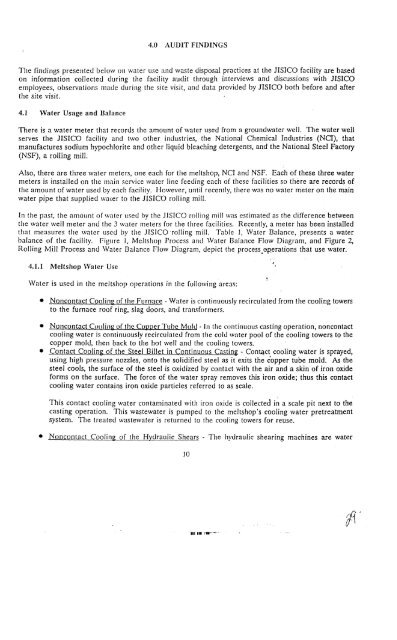Watcr Q!!alit\1 lmprovcmct1t at1() COf1scrvatiof1l'rojcct
Watcr Q!!alit\1 lmprovcmct1t at1() COf1scrvatiof1l'rojcct
Watcr Q!!alit\1 lmprovcmct1t at1() COf1scrvatiof1l'rojcct
Create successful ePaper yourself
Turn your PDF publications into a flip-book with our unique Google optimized e-Paper software.
4.0 AUDIT FINDINGS<br />
The findings presented below on watcr use and waste disposal practices at the JISICO facility are based<br />
on information collected during the facility audit through interviews and discussions with JISICO<br />
employees, observations madc during thc site visit, and data provided by JISICO both before and after<br />
the site visit.<br />
4.1 Water Usage and Balance<br />
There is a water meter that records thc amount of water used from a groundwater well. The water well<br />
serves the JISICO facility and two other industries, the National Chemical Industries (NO), that<br />
manufactures sodium hypochlorite and other liquid bleaching detergents, and the National Steel Factory<br />
(NSF), a rolling mill.<br />
Also, there are three water meters, one each for the meltshop, NCr and NSF. Each of these three water<br />
meters is installed on thc main scrvicc watcr linc fceding each of thesc facilities so there are records of<br />
the amount of water used by cach facility. However, until recently, there was no water meter on the main<br />
water pipe that supplied waler to the JISICO rolling mill.<br />
In the past, the amount of water used by thc JISICO rolling mill was estimated as the difference between<br />
the water well meter and thc 3 water meters for the three facilities. Recently, a meter has been installed<br />
that measures the watcr uscd by the JISICO rolling mill. Tablc 1, <strong>Watcr</strong> Balance, presents a water<br />
balance of the facility. figure I, Mcltshop Process and Water Balance Flow Diagram, and Figure 2,<br />
Rolling Mill Process and Water Balance Flow Diagram, depict the process.operations that use water.<br />
4.1.1 MeItshop 'Vater Use<br />
Water is used in the meltshop operations in the following areas:<br />
• Noncontact Cooling of the Furnace - Water is continuously recirculated from the cooling towers<br />
to the furnace roof ring, slag doors, and transformers.<br />
• Noncontact Cooling of the Copper Tuhe Mold - In the continuous casting opcration, noncontact<br />
cooling watcr is continuously recirculated from the cold water pool of the cooling towers to the<br />
copper mold, then back to the hot well and the cooling towers.<br />
• Contact Cooling of the Steel Billet in Continuous Casting - ConUl,ct cooling water is sprayed,<br />
using high pressure nozzles, onto the solidified steel as it exits the c'opper tube mold. As the<br />
steel cools, the surface of the steel is oxidized by contact with the air and a skin of iron oxide<br />
forms on the surface. The force of the water spray removes this iron oxide; thus this contact<br />
cooling water contains iron oxide particles referred to as scale.<br />
This contact cooling water contaminated with iron oxide is collected in a scale pit next to the<br />
casting operation. 1llis wastewater is pumped to the meltshop's cooling water pretreatment<br />
system. 1lle treated wastewater is returned to the cooling towers for reuse.<br />
.,<br />
• Noncontact Cooling of the Hydraulic Shears - The hydraulic shearing machines are water<br />
10<br />
11'

















